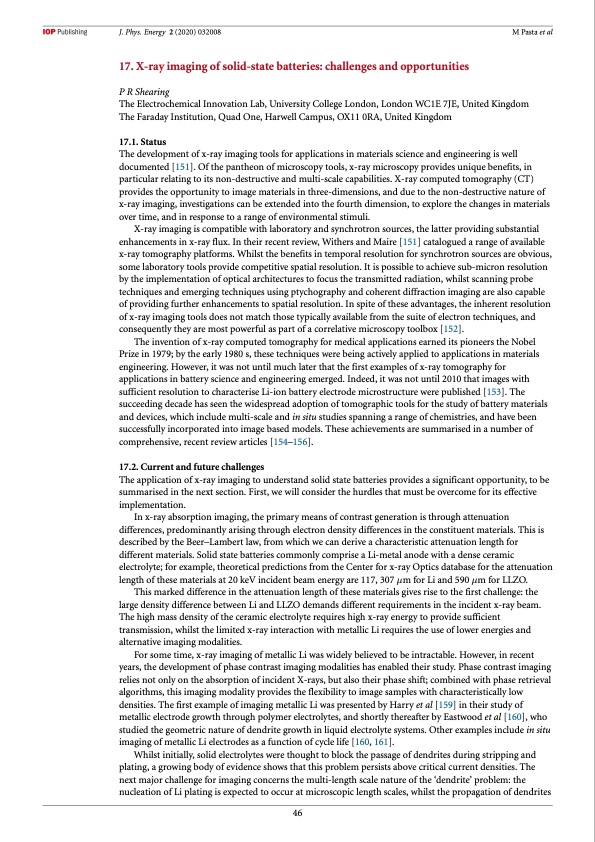
PDF Publication Title:
Text from PDF Page: 047
J. Phys. Energy 2 (2020) 032008 M Pasta et al 17. X-ray imaging of solid-state batteries: challenges and opportunities P R Shearing The Electrochemical Innovation Lab, University College London, London WC1E 7JE, United Kingdom The Faraday Institution, Quad One, Harwell Campus, OX11 0RA, United Kingdom 17.1. Status The development of x-ray imaging tools for applications in materials science and engineering is well documented [151]. Of the pantheon of microscopy tools, x-ray microscopy provides unique benefits, in particular relating to its non-destructive and multi-scale capabilities. X-ray computed tomography (CT) provides the opportunity to image materials in three-dimensions, and due to the non-destructive nature of x-ray imaging, investigations can be extended into the fourth dimension, to explore the changes in materials over time, and in response to a range of environmental stimuli. X-ray imaging is compatible with laboratory and synchrotron sources, the latter providing substantial enhancements in x-ray flux. In their recent review, Withers and Maire [151] catalogued a range of available x-ray tomography platforms. Whilst the benefits in temporal resolution for synchrotron sources are obvious, some laboratory tools provide competitive spatial resolution. It is possible to achieve sub-micron resolution by the implementation of optical architectures to focus the transmitted radiation, whilst scanning probe techniques and emerging techniques using ptychography and coherent diffraction imaging are also capable of providing further enhancements to spatial resolution. In spite of these advantages, the inherent resolution of x-ray imaging tools does not match those typically available from the suite of electron techniques, and consequently they are most powerful as part of a correlative microscopy toolbox [152]. The invention of x-ray computed tomography for medical applications earned its pioneers the Nobel Prize in 1979; by the early 1980 s, these techniques were being actively applied to applications in materials engineering. However, it was not until much later that the first examples of x-ray tomography for applications in battery science and engineering emerged. Indeed, it was not until 2010 that images with sufficient resolution to characterise Li-ion battery electrode microstructure were published [153]. The succeeding decade has seen the widespread adoption of tomographic tools for the study of battery materials and devices, which include multi-scale and in situ studies spanning a range of chemistries, and have been successfully incorporated into image based models. These achievements are summarised in a number of comprehensive, recent review articles [154–156]. 17.2. Current and future challenges The application of x-ray imaging to understand solid state batteries provides a significant opportunity, to be summarised in the next section. First, we will consider the hurdles that must be overcome for its effective implementation. In x-ray absorption imaging, the primary means of contrast generation is through attenuation differences, predominantly arising through electron density differences in the constituent materials. This is described by the Beer–Lambert law, from which we can derive a characteristic attenuation length for different materials. Solid state batteries commonly comprise a Li-metal anode with a dense ceramic electrolyte; for example, theoretical predictions from the Center for x-ray Optics database for the attenuation length of these materials at 20 keV incident beam energy are 117, 307 μm for Li and 590 μm for LLZO. This marked difference in the attenuation length of these materials gives rise to the first challenge: the large density difference between Li and LLZO demands different requirements in the incident x-ray beam. The high mass density of the ceramic electrolyte requires high x-ray energy to provide sufficient transmission, whilst the limited x-ray interaction with metallic Li requires the use of lower energies and alternative imaging modalities. For some time, x-ray imaging of metallic Li was widely believed to be intractable. However, in recent years, the development of phase contrast imaging modalities has enabled their study. Phase contrast imaging relies not only on the absorption of incident X-rays, but also their phase shift; combined with phase retrieval algorithms, this imaging modality provides the flexibility to image samples with characteristically low densities. The first example of imaging metallic Li was presented by Harry et al [159] in their study of metallic electrode growth through polymer electrolytes, and shortly thereafter by Eastwood et al [160], who studied the geometric nature of dendrite growth in liquid electrolyte systems. Other examples include in situ imaging of metallic Li electrodes as a function of cycle life [160, 161]. Whilst initially, solid electrolytes were thought to block the passage of dendrites during stripping and plating, a growing body of evidence shows that this problem persists above critical current densities. The next major challenge for imaging concerns the multi-length scale nature of the ‘dendrite’ problem: the nucleation of Li plating is expected to occur at microscopic length scales, whilst the propagation of dendrites 46PDF Image | 2020 roadmap on solid-state batteries

PDF Search Title:
2020 roadmap on solid-state batteriesOriginal File Name Searched:
Pasta_2020_J_Phys_Energy_2_032008.pdfDIY PDF Search: Google It | Yahoo | Bing
Sulfur Deposition on Carbon Nanofibers using Supercritical CO2 Sulfur Deposition on Carbon Nanofibers using Supercritical CO2. Gamma sulfur also known as mother of pearl sulfur and nacreous sulfur... More Info
CO2 Organic Rankine Cycle Experimenter Platform The supercritical CO2 phase change system is both a heat pump and organic rankine cycle which can be used for those purposes and as a supercritical extractor for advanced subcritical and supercritical extraction technology. Uses include producing nanoparticles, precious metal CO2 extraction, lithium battery recycling, and other applications... More Info
| CONTACT TEL: 608-238-6001 Email: greg@infinityturbine.com | RSS | AMP |